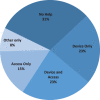Self-care training using the Tablo hemodialysis system
- PMID: 33047477
- PMCID: PMC7891342
- DOI: 10.1111/hdi.12890
Self-care training using the Tablo hemodialysis system
Abstract
Introduction: Recently published results of the investigational device exemption (IDE) trial using the Tablo hemodialysis system confirmed its safety and efficacy for home dialysis. This manuscript reports additional data from the Tablo IDE study on the training time required to be competent in self-care, the degree of dependence on health care workers and caregivers after training was complete, and participants' assessment of the ease-of-use of Tablo.
Methods: We collected data on the time required to set up concentrates and the Tablo cartridge prior to treatment initiation. We asked participants to rate system setup, treatment, and takedown on a Likert scale from 1 (very difficult) to 5 (very simple) and if they had required any assistance with any aspect of treatment over the prior 7 days. In a subgroup of 15 participants, we recorded the number of training sessions required to be deemed competent to do self-care dialysis.
Findings: Eighteen men and 10 women with a mean age of 52.6 years completed the study. Thirteen had previous self-care experience using a different dialysis system. Mean set up times for the concentrates and cartridge were 1.1 and 10.0 minutes, respectively. Participants with or without previous self-care experience had similar set-up times. The mean ease-of-use score was 4.5 or higher on a scale from 1 to 5 during the in-home phase. Sixty-five percent required no assistance at home and on average required fewer than four training sessions to be competent in managing their treatments. Results were similar for participants with or without previous self-care experience.
Conclusions: Participants in the Tablo IDE trial were able to quickly learn and manage hemodialysis treatments in the home, found Tablo easy to use, and were generally independent in performing hemodialysis.
Keywords: Self-care; hemodialysis; training.
© 2020 The Authors. Hemodialysis International published by Wiley Periodicals LLC on behalf of International Society for Hemodialysis.
Figures



References
-
- United States Renal Data System . USRDS Annual Data Report: Epidemiology of Kidney Disease in the United States. National Institutes of Health. Bethesda, MD: National Institute of Diabetes and Digestive and Kidney Diseases, 2018;p. 2018.
-
- Marshall M, Polkinghorne K, Kerr P. Intensive hemodialysis and mortality risk in Australian and New Zealand population. Am J Kidney Dis. 2016;67:617–628. - PubMed
-
- Lee H, Manns B, Taub K, et al. Cost analysis of ongoing care of patients with end‐stage renal disease: The impact of dialysis modality and dialysis access. Am J Kidney Dis. 2002;40:611–622. - PubMed
Publication types
MeSH terms
LinkOut - more resources
Full Text Sources
Medical

